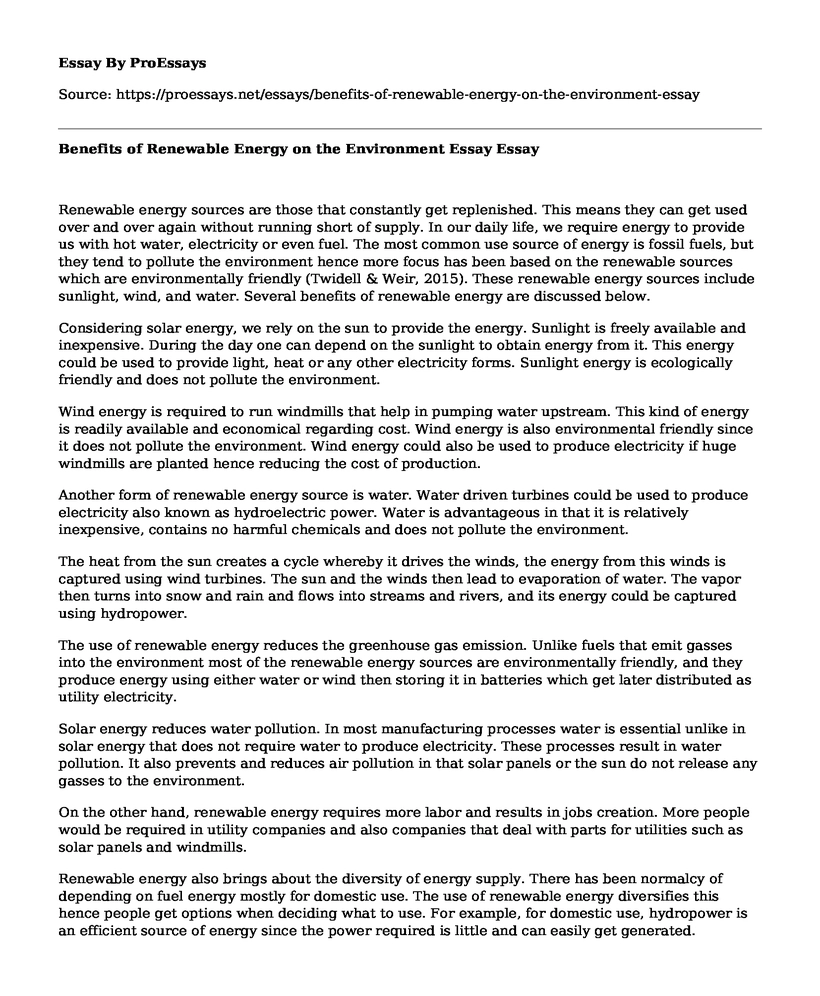Renewable energy sources are those that constantly get replenished. This means they can get used over and over again without running short of supply. In our daily life, we require energy to provide us with hot water, electricity or even fuel. The most common use source of energy is fossil fuels, but they tend to pollute the environment hence more focus has been based on the renewable sources which are environmentally friendly (Twidell & Weir, 2015). These renewable energy sources include sunlight, wind, and water. Several benefits of renewable energy are discussed below.
Considering solar energy, we rely on the sun to provide the energy. Sunlight is freely available and inexpensive. During the day one can depend on the sunlight to obtain energy from it. This energy could be used to provide light, heat or any other electricity forms. Sunlight energy is ecologically friendly and does not pollute the environment.
Wind energy is required to run windmills that help in pumping water upstream. This kind of energy is readily available and economical regarding cost. Wind energy is also environmental friendly since it does not pollute the environment. Wind energy could also be used to produce electricity if huge windmills are planted hence reducing the cost of production.
Another form of renewable energy source is water. Water driven turbines could be used to produce electricity also known as hydroelectric power. Water is advantageous in that it is relatively inexpensive, contains no harmful chemicals and does not pollute the environment.
The heat from the sun creates a cycle whereby it drives the winds, the energy from this winds is captured using wind turbines. The sun and the winds then lead to evaporation of water. The vapor then turns into snow and rain and flows into streams and rivers, and its energy could be captured using hydropower.
The use of renewable energy reduces the greenhouse gas emission. Unlike fuels that emit gasses into the environment most of the renewable energy sources are environmentally friendly, and they produce energy using either water or wind then storing it in batteries which get later distributed as utility electricity.
Solar energy reduces water pollution. In most manufacturing processes water is essential unlike in solar energy that does not require water to produce electricity. These processes result in water pollution. It also prevents and reduces air pollution in that solar panels or the sun do not release any gasses to the environment.
On the other hand, renewable energy requires more labor and results in jobs creation. More people would be required in utility companies and also companies that deal with parts for utilities such as solar panels and windmills.
Renewable energy also brings about the diversity of energy supply. There has been normalcy of depending on fuel energy mostly for domestic use. The use of renewable energy diversifies this hence people get options when deciding what to use. For example, for domestic use, hydropower is an efficient source of energy since the power required is little and can easily get generated.
As mentioned earlier, renewable energy is environmentally friendly and produces no hazardous gasses to the environment; this extends to improve public health. This kind of energy is not only environmentally friendly but user-friendly hence not harmful to the user.
Finally, renewable energy brings about individual energy independence. In many nations, there is increased need for air conditioners during the cold season, and this leaves many others suffering as a result of blowouts. Solar energy could be used to curb this demand and increase dependency amongst individuals. This means that in case of blowouts you will still be able to use the solar energy to light up the homestead. General renewable energy is beneficial in many ways which are advantageous to the user and the environment. The two main benefits are; it is environmentally friendly and saves on money compared to other sources of energy.
References
Twidell, J., & Weir, T. (2015). Renewable energy resources. Routledge.
Tan, S. T., Hashim, H., Lim, J. S., Ho, W. S., Lee, C. T., & Yan, J. (2014). Energy and emissions benefits of renewable energy derived from municipal solid waste: analysis of a low carbon scenario in Malaysia. Applied Energy, 136, 797-804.
Berrill, P., Arvesen, A., Scholz, Y., Gils, H. C., & Hertwich, E. G. (2016). Environmental impacts of high penetration renewable energy scenarios for Europe. Environmental Research Letters, 11(1), 014012.
Zhao, H. R., Guo, S., & Fu, L. W. (2014). Review on the costs and benefits of renewable energy power subsidy in China. Renewable and Sustainable Energy Reviews, 37, 538-549.
Cite this page
Benefits of Renewable Energy on the Environment Essay. (2022, Jun 19). Retrieved from https://proessays.net/essays/benefits-of-renewable-energy-on-the-environment-essay
If you are the original author of this essay and no longer wish to have it published on the ProEssays website, please click below to request its removal:
- Pollution Prevention Practices Essays Example
- Essay Example on Urban Solid Waste Management: Challenges & Solutions
- Abstract for International and Comparative Disaster Law
- NanoRobots for Cancer Treatment: Inhibition of Progression - Annotated Bibliography
- Ban Cell Phones While Driving: A Necessity Nationwide - Essay Sample
- Artificial Intelligence: Exploring Different Definitions and Implications - Essay Sample
- Oculus Virtual Reality and Ethical Issues - Report Sample







